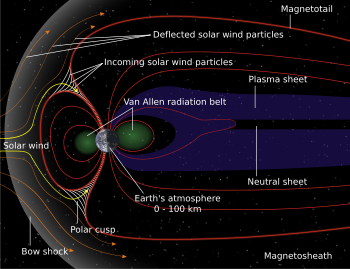Our website is made possible by displaying online advertisements to our visitors.
Please consider supporting us by disabling your ad blocker.
Magnetosheath
The magnetosheath is the region of space between the magnetopause and the bow shock of a planet's magnetosphere. The regularly organized magnetic field generated by the planet becomes weak and irregular in the magnetosheath due to interaction with the incoming solar wind, and is incapable of fully deflecting the highly charged particles. The density of the particles in this region is considerably lower than what is found beyond the bow shock, but greater than within the magnetopause, and can be considered a transitory state.[1][2]

Scientific research into the exact nature of the magnetosheath has been limited due to a longstanding misconception that it was a byproduct of the bow shock/magnetopause interaction and had no inherently important properties of its own. Recent studies indicate, however, that the magnetosheath is a dynamic region of turbulent plasma flow which may play an important role in the structure of the bow shock and the magnetopause, and might help to dictate the flow of energetic particles across those boundaries.[3][4] Kinetic plasma instabilities may cause further complexity by generating plasma waves and energetic particle beams in the magnetosheath and foreshock regions.[5]
The Earth's magnetosheath typically occupies the region of space approximately 10 Earth radii on the upwind (Sun-facing) side of the planet, extending significantly further out on the downwind side due to the pressure of the solar wind. The exact location and width of the magnetosheath depends on variables such as solar activity.[6]
- ^ "Magnetosheath".
- ^ Iver Cairns (September 1999). http://www.physics.usyd.edu.au/~cairns/teaching/lecture14/node2.html
- ^ W. Baumjohann, R. Nakamura, in Treatise on Geophysics (2007). https://www.sciencedirect.com/topics/physics-and-astronomy/magnetosheath
- ^ Emiliya Yordanova, Zoltán Vörös, Savvas Raptis and Tomas Karlsson (February 2020). https://www.frontiersin.org/articles/10.3389/fspas.2020.00002/full
- ^ Pokhotelov, D.; von Alfthan, S.; Kempf, Y.; et al. (2013-12-17). "Ion distributions upstream and downstream of the Earth's bow shock: first results from Vlasiator". Annales Geophysicae. 31 (12): 2207–2212. Bibcode:2013AnGeo..31.2207P. doi:10.5194/angeo-31-2207-2013. hdl:10138/161497.
- ^ Ali H. Sulaiman, Adam Masters, Michele K. Dougherty, and Xianzhe Jia "The Magnetic Structure of Saturn's Magnetosheath" from "JOURNAL OF GEOPHYSICAL RESEARCH, VOL. 119, 5651 - 5661, DOI: 10.1002/2014JA020019" (February 2015). https://arxiv.org/ftp/arxiv/papers/1502/1502.05504.pdf
Previous Page Next Page


